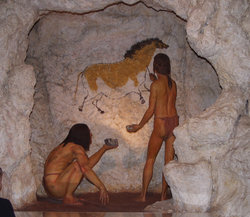Prehistory
|
|
Prehistory is the period of human history including all previous history before humans which is prior to the advent of writing (which marks the beginning of recorded history).
| Contents [hide] |
Eras
Prehistory consists of the period of human history from which no written records have survived. Although people disagree as to when prehistory began, it is commonly cited as having begun about 100,000 to 200,000 years ago with the appearance of the first modern Homo sapiens. However, some would say that prehistory began much earlier, with the invention of the first tools about 2.5 million years ago around the area now known as Olduvai Gorge. Others would date the beginning of prehistory with the advent of Homo erectus c. 1.5 million years ago, or with that of Cro-Magnon around 40,000 BC.
The date marking the end of prehistory is also disputed. In Egypt it is generally accepted that prehistory ended around 3500 BC whereas in New Guinea the end of the prehistoric era is set much more recently, AD 1900.
Because, by definition there are no written records from prehistoric times, much of the information we know about the time period is deduced from the study of artifacts left behind by ancient peoples.
Age system
Prehistory is often subdivided by a three-age system. This system of classifying human prehistory creates three consecutive time periods, named for their respective predominant tool-making technologies.
Stone Age
The Stone Age is the time period during which humans created tools from stone. Wood, bone and other materials were also used, but stone (in particular flint) was more durable and was increasingly easily shaped for use as cutting tools and weapons. The date range of this period is ambiguous, disputed, and variable according to the region in question. It includes:
- Paleolithic – Old Stone Age. This period is the oldest part of the stone age, dating from the first use of stone tools by hominids (maybe 2,000,000 years ago) to the end of the Pleistocene epoch.
- Epipalaeolithic – characterised by the use of microliths, not distinguished by all scholars. It is the last period of the Palaeolithic according to some of the classification schemes used in archaeology.
- Mesolithic – Middle Stone Age. It began at the end of the Pleistocene epoch around 10,000 years ago and ended with the introduction of farming, the date of which varied in each geographical region.
- Neolithic – Late Stone Age, usually referring to the beginnings of agriculture. It is traditionally the last part of the stone age. It followed Pleistocene epipalaeolithic and early Holocene Mesolithic cultures with the start of farming and ended when metal tools came into widespread use in the Copper Age
- Chalcolithic or Eneolithic (also "the Copper Age") – mixed stone and metal tools, not a period distinguished by all scholars. It is a phase in the development of human culture in which the use of early metal tools appeared alongside the use of stone tools.
Bronze Age
The Bronze Age began with the first widespread use of copper and bronze tools. It was a period in a civilization's development when the most advanced metalworkers developed the techniques of smelting copper from natural outcroppings and creating alloys such as bronze, which was much harder than any metal to be found in nature.
Iron Age
The Iron Age is the period in a civilisation's development at which time iron working was the most sophisticated form of metalworking achieved. It began around 1203 BC in Turkey and the Caucasus Mountains and eventually spread throughout the civilized world. Polynesia did not enter the Iron Age until the coming of the Europeans, between 1500 and 1750 CE. The end of the Iron age is normally defined by the appearance of written records.

